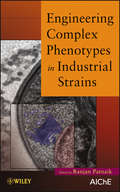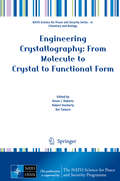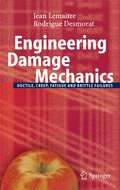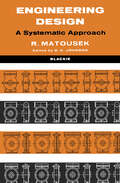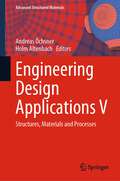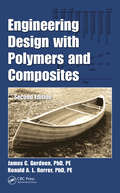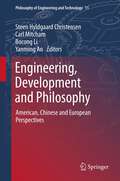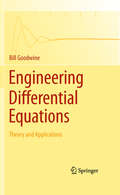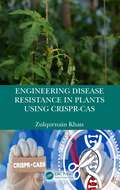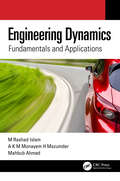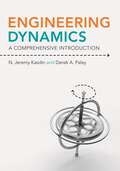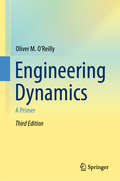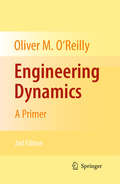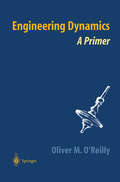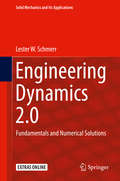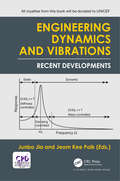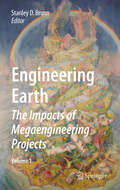- Table View
- List View
Engineering Complex Phenotypes in Industrial Strains
by Ranjan PatnaikThis book highlights current trends and developments in the area of engineering strains. The book details the current and future tools used in the production of bulk chemicals and biofuels from renewable biomass using green technologies. Complex phenotypes are traits in a microbe that requires multiple genetic changes to be modulated simultaneously in the microorganism’s DNA. Knowing what those genetic changes are for a given trait and how to make those changes in the most efficient way forms the motivation behind writing this book. This book explains the newer tools to develop and enable engineered strains at time scales much faster that the natural evolution process so that we can increase a cells' production of a certain substance, increase process productivity, and extend metabolic capability. This book provides a one stop platform of reference for practicing researchers in the field of industrial biotechnology. This book also explains that the commercial success of a process that uses microbial catalysts over platforms that use chemical catalysts and fossil fuels depends on the time it takes to engineer these microbes to perform the desired reaction under harsh manufacturing conditions and at rates that meets the criteria for economic feasibility.
Engineering Complex Phenotypes in Industrial Strains
by Ranjan PatnaikThis book highlights current trends and developments in the area of engineering strains. The book details the current and future tools used in the production of bulk chemicals and biofuels from renewable biomass using green technologies. Complex phenotypes are traits in a microbe that requires multiple genetic changes to be modulated simultaneously in the microorganism’s DNA. Knowing what those genetic changes are for a given trait and how to make those changes in the most efficient way forms the motivation behind writing this book. This book explains the newer tools to develop and enable engineered strains at time scales much faster that the natural evolution process so that we can increase a cells' production of a certain substance, increase process productivity, and extend metabolic capability. This book provides a one stop platform of reference for practicing researchers in the field of industrial biotechnology. This book also explains that the commercial success of a process that uses microbial catalysts over platforms that use chemical catalysts and fossil fuels depends on the time it takes to engineer these microbes to perform the desired reaction under harsh manufacturing conditions and at rates that meets the criteria for economic feasibility.
Engineering Crystallography: From Molecule to Crystal to Functional Form (NATO Science for Peace and Security Series A: Chemistry and Biology)
by Kevin J. Roberts Robert Docherty Rui TamuraThis book highlights the current state-of-the-art regarding the application of applied crystallographic methodologies for understanding, predicting and controlling the transformation from the molecular to crystalline state with the latter exhibiting pre-defined properties. This philosophy is built around the fundamental principles underpinning the three inter-connected themes of Form (what), Formation (how) and Function (why). Topics covered include: molecular and crystal structure, chirality and ferromagnetism, supramolecular assembly, defects and reactivity, morphology and surface energetics. Approaches for preparing crystals and nano-crystals with novel physical, chemical and mechanical properties include: crystallisation, seeding, phase diagrams, polymorphic control, chiral separation, ultrasonic techniques and mechano-chemistry. The vision is realised through examination of a range of advanced analytical characterisation techniques including in-situ studies. The work is underpinned through an unprecedented structural perspective of molecular features, solid-state packing arrangements and surface energetics as well as in-situ studies. This work will be of interest to researchers, industrialists, intellectual property specialists and policy makers interested in the latest developments in the design and supply of advanced high added-value organic solid-form materials and product composites.
Engineering Damage Mechanics: Ductile, Creep, Fatigue and Brittle Failures
by Jean Lemaitre Rodrigue DesmoratReflecting his major contributions to the field, Jean Lemaitre’s "Engineering Damage Mechanics" presents simplified and advanced methods organized within a unified framework for designers of any mechanical component. Explains how to apply continuous damage mechanics to failures of mechanical and civil engineering components in ductile, creep, fatigue and brittle conditions. Incorporates many basic examples, while emphasizing key practical considerations such as material parameter identification, and provides perspective on the advantage and disadvantages of various approaches.
Engineering Design: A Systematic Approach
by Robert MatousekTO THE GERMAN EDITION This book is addressed to those engineering students who are prepared to work-not to such as are content to refurbish existing designs without taking the trouble to understand the trains of thought and the considerations which are needed in true design work. It is a well-established fact that the beginner, confronted by the simplest of design problems, and lacking a pattern or model to suggest a solution, loses his way in endless trial and error unless given positive guidance. In this book, therefore, the author has drawn on his long teaching experience in an attempt to present in a readily understandable and systematic manner a methodical work plan which will enable the beginner practising design problems to reach his objective by a rational route. This approach has the further advantage. con firmed by experience, that in adopting it the student will find his interest and pleasure in design work growing, and his self-confidence increasing. Written with the requirements of general mechanical engineering in mind, the book does not deal with the manufacturing methods typical of light precision engineering. To prevent the book from taking on a size which would have detracted from its clear layout and obscured the main principles presented, the numerical tables, graphs, etc. available for reference in pocket books and textbooks have been omitted.
Engineering Design Applications V: Structures, Materials and Processes (Advanced Structured Materials #171)
by Andreas Öchsner Holm AltenbachThis book gives an update on recent developments in different engineering disciplines such as mechanical, materials, computer and process engineering, focusing on modern engineering design applications. These disciplines provide the foundation for the design and development of improved structures, materials and processes. The modern design cycle is characterized by an interaction of different disciplines and a strong shift to computer-based approaches where only a few experiments are performed for verification purposes. A major driver for this development is the increased demand for cost reduction, which is also connected to environmental demands. In the transportation industry (e.g., automotive), this is connected to the demand for higher fuel efficiency, which is related to the operational costs and the lower harm for the environment. One way to fulfill such requirements is lighter structures and/or improved processes for energy conversion. Another emerging area is the interaction of classical engineering with the health, medical and environmental sector. The chapters are selected contributions of the Advanced Computational Engineering and Experimenting conference, held in July 2022 in Florence, Italy.
Engineering Design Applications VI: Structures, Materials and Processes (Advanced Structured Materials #209)
by Andreas Öchsner Holm AltenbachThis book gives an update on recent developments in the mentioned areas of modern engineering design application. Different engineering disciplines such as mechanical, materials, computer and process engineering provide the foundation for the design and development of improved structures, materials and processes. The modern design cycle is characterized by an interaction of different disciplines and a strong shift to computer-based approaches where only a few experiments are performed for verification purposes. A major driver for this development is the increased demand for cost reduction, which is also connected to environmental demands. In the transportation industry (e.g. automotive), this is connected with the demand for higher fuel efficiency, which is related to the operational costs and the lower harm for the environment. One way to fulfil such requirements are lighter structures and/or improved processes for energy conversion. Another emerging area is the interaction of classical engineering with the health, medical, and environmental sectors.
Engineering Design for Wear, Revised and Expanded (Mechanical Engineering)
by Raymond G. BayerA modern presentation of approaches to wear design, this significantly revised and expanded second edition offers methods suited for meeting specific wear performance requirements, numerous design studies highlighting strategies for use with different tribological elements and mechanical systems, proven tactics for resolving wear-related problems,
Engineering Design for Wear, Revised and Expanded (Mechanical Engineering)
by Raymond G. BayerA modern presentation of approaches to wear design, this significantly revised and expanded second edition offers methods suited for meeting specific wear performance requirements, numerous design studies highlighting strategies for use with different tribological elements and mechanical systems, proven tactics for resolving wear-related problems,
Engineering Design with Polymers and Composites
by James C. Gerdeen Ronald A. L. RorrerEngineering Design with Polymers and Composites, Second Edition continues to provide one of the only textbooks on the analysis and design of mechanical components made from polymer materials. It explains how to create polymer materials to meet design specifications. After tracing the history of polymers and composites, the text describes modern des
Engineering, Development and Philosophy: American, Chinese and European Perspectives (Philosophy of Engineering and Technology #11)
by Steen Hyldgaard Christensen, Carl Mitcham, Bocong Li and Yanming AnThis inclusive, cross-cultural study rethinks the nexus between engineering, development, and culture. It offers diverse commentary from a range of disciplinary perspectives on how the philosophies of today’s cultural triumvirate—American, European and Chinese—are shaped and given nuance by the cross-fertilization of engineering and development. Scholars from the humanities and social sciences as well as engineers themselves reflect on key questions that arise in this relational context, such as how international development work affects the professional views, identities, practice and ethics of engineers. The first volume to offer a systematic and collaborative study that cuts across continental boundaries, the book delineates the kinds of skills and competences that tomorrow’s engineering success stories will require, and analyzes fascinating aspects of the interplay between engineering and philosophy, such as how traditionally Chinese ways of thinking can influence modern engineering practice in the world’s most populous country. China’s problematic mix of engineering woes and wonders, from the high-profile crash on its high-profile rail network to its ‘bird’s nest’ Olympic stadium, adds to the urgency for reform, while Europe’s Enlightenment-informed legal frameworks are contrasted with Chinese mechanisms in their governance of the field of nanotechnology, a crucial element of future technical evolution. Fascinating and compelling in equal measure, this volume addresses one of the topics at the leading edge of humanity’s quest to survive, and to thrive.
Engineering Differential Equations: Theory and Applications
by Bill GoodwineThis book is a comprehensive treatment of engineering undergraduate differential equations as well as linear vibrations and feedback control. While this material has traditionally been separated into different courses in undergraduate engineering curricula. This text provides a streamlined and efficient treatment of material normally covered in three courses. Ultimately, engineering students study mathematics in order to be able to solve problems within the engineering realm. Engineering Differential Equations: Theory and Applications guides students to approach the mathematical theory with much greater interest and enthusiasm by teaching the theory together with applications. Additionally, it includes an abundance of detailed examples. Appendices include numerous C and FORTRAN example programs. This book is intended for engineering undergraduate students, particularly aerospace and mechanical engineers and students in other disciplines concerned with mechanical systems analysis and control. Prerequisites include basic and advanced calculus with an introduction to linear algebra.
Engineering Disease Resistance in Plants using CRISPR-Cas
by Zulqurnain KhanCRISPR genome-editing technology presents opportunities to engineer disease resistance traits in plants and improve crop quality. Engineering Disease Resistance in Plants using CRISPR-Cas introduces readers to the basics of CRISPR-Cas and discusses its potential uses in various fields. The book focuses on methods of developing disease-resistant crops using CRISPR-Cas–mediated plant disease resistance modification. Comprehensively written, the author details all types and variants of the CRISPR toolkit. The book opens with information on the evolution of the CRISPR technology and follows a chronology of its development. Although the book concentrates on the use of CRISPR-Cas for disease resistance in plants, it also covers the technology's broader potential examining the history and development of other genome-editing tools. Key Features: Investigates the regulatory, ethical, and societal considerations while designing experiments. Discusses topics on disease development, control, and plant defense mechanisms. Examines genome-editing tools including Zinc Finger Nucleases (ZFNs) and Transcription Activator-Like Effector Nucleases (TALENs). Examines production technology to reduce bacterial, fungal, and viral diseases. Provides information for users to discover ways to overcome the challenges associated with food security. This book is a valuable resource for researchers, scientists, and undergraduate and graduate students who wish to gain a comprehensive understanding of genome-editing methods.
Engineering Disease Resistance in Plants using CRISPR-Cas
by Zulqurnain KhanCRISPR genome-editing technology presents opportunities to engineer disease resistance traits in plants and improve crop quality. Engineering Disease Resistance in Plants using CRISPR-Cas introduces readers to the basics of CRISPR-Cas and discusses its potential uses in various fields. The book focuses on methods of developing disease-resistant crops using CRISPR-Cas–mediated plant disease resistance modification. Comprehensively written, the author details all types and variants of the CRISPR toolkit. The book opens with information on the evolution of the CRISPR technology and follows a chronology of its development. Although the book concentrates on the use of CRISPR-Cas for disease resistance in plants, it also covers the technology's broader potential examining the history and development of other genome-editing tools. Key Features: Investigates the regulatory, ethical, and societal considerations while designing experiments. Discusses topics on disease development, control, and plant defense mechanisms. Examines genome-editing tools including Zinc Finger Nucleases (ZFNs) and Transcription Activator-Like Effector Nucleases (TALENs). Examines production technology to reduce bacterial, fungal, and viral diseases. Provides information for users to discover ways to overcome the challenges associated with food security. This book is a valuable resource for researchers, scientists, and undergraduate and graduate students who wish to gain a comprehensive understanding of genome-editing methods.
Engineering Dynamics: Fundamentals and Applications
by M Rashad Islam A K Mazumder Mahbub AhmedThis textbook is intended for the first course of engineering dynamics for undergraduate students. Engineering dynamics is a rigorous topic that typically involves the intensive use of vector mathematics and calculus. This book, however, uses plain language with less vector mathematics and calculus to introduce these topics of mathematics to students with a high school physics background. Numerous practical examples are provided with their step-by-step worked out solutions, as well as case studies to reflect the interests of new engineering and applied engineering students. The topics covered in the Fundamentals of Engineering (FE) examination are presented throughout the text. It also includes roadway dynamics to incorporate engineering dynamics and transportation engineering for civil engineering. Features: Discusses theory using easy-to-understand language with less vector mathematics and calculus Includes practical case studies and numerous realistic step-by-step solved examples Includes exercise problems for students’ practice Provides numerous sample examples related to the Fundamentals of Engineering (FE) exam Includes a solutions manual and PowerPoint slides for adopting instructors Engineering Dynamics: Fundamentals and Applications serves as a useful resource for students across several engineering degree programs, such as civil, mechanical, aerospace, automotive, chemical, and electrical engineering. It is also appropriate for engineering technology and applied science students as well.
Engineering Dynamics: Fundamentals and Applications
by M Rashad Islam A K Mazumder Mahbub AhmedThis textbook is intended for the first course of engineering dynamics for undergraduate students. Engineering dynamics is a rigorous topic that typically involves the intensive use of vector mathematics and calculus. This book, however, uses plain language with less vector mathematics and calculus to introduce these topics of mathematics to students with a high school physics background. Numerous practical examples are provided with their step-by-step worked out solutions, as well as case studies to reflect the interests of new engineering and applied engineering students. The topics covered in the Fundamentals of Engineering (FE) examination are presented throughout the text. It also includes roadway dynamics to incorporate engineering dynamics and transportation engineering for civil engineering. Features: Discusses theory using easy-to-understand language with less vector mathematics and calculus Includes practical case studies and numerous realistic step-by-step solved examples Includes exercise problems for students’ practice Provides numerous sample examples related to the Fundamentals of Engineering (FE) exam Includes a solutions manual and PowerPoint slides for adopting instructors Engineering Dynamics: Fundamentals and Applications serves as a useful resource for students across several engineering degree programs, such as civil, mechanical, aerospace, automotive, chemical, and electrical engineering. It is also appropriate for engineering technology and applied science students as well.
Engineering Dynamics: A Comprehensive Introduction
by N. Jeremy Kasdin Derek A. PaleyThis textbook introduces undergraduate students to engineering dynamics using an innovative approach that is at once accessible and comprehensive. Combining the strengths of both beginner and advanced dynamics texts, this book has students solving dynamics problems from the very start and gradually guides them from the basics to increasingly more challenging topics without ever sacrificing rigor. Engineering Dynamics spans the full range of mechanics problems, from one-dimensional particle kinematics to three-dimensional rigid-body dynamics, including an introduction to Lagrange's and Kane's methods. It skillfully blends an easy-to-read, conversational style with careful attention to the physics and mathematics of engineering dynamics, and emphasizes the formal systematic notation students need to solve problems correctly and succeed in more advanced courses. This richly illustrated textbook features numerous real-world examples and problems, incorporating a wide range of difficulty; ample use of MATLAB for solving problems; helpful tutorials; suggestions for further reading; and detailed appendixes. Provides an accessible yet rigorous introduction to engineering dynamics Uses an explicit vector-based notation to facilitate understanding Professors: A supplementary Instructor's Manual is available for this book. It is restricted to teachers using the text in courses. For information on how to obtain a copy, refer to: http://press.princeton.edu/class_use/solutions.html
Engineering Dynamics: A Comprehensive Introduction
by N. Jeremy Kasdin Derek A. PaleyAn accessible yet rigorous introduction to engineering dynamicsThis textbook introduces undergraduate students to engineering dynamics using an innovative approach that is at once accessible and comprehensive. Combining the strengths of both beginner and advanced dynamics texts, this book has students solving dynamics problems from the very start and gradually guides them from the basics to increasingly more challenging topics without ever sacrificing rigor.Engineering Dynamics spans the full range of mechanics problems, from one-dimensional particle kinematics to three-dimensional rigid-body dynamics, including an introduction to Lagrange's and Kane's methods. It skillfully blends an easy-to-read, conversational style with careful attention to the physics and mathematics of engineering dynamics, and emphasizes the formal systematic notation students need to solve problems correctly and succeed in more advanced courses. This richly illustrated textbook features numerous real-world examples and problems, incorporating a wide range of difficulty; ample use of MATLAB for solving problems; helpful tutorials; suggestions for further reading; and detailed appendixes.Provides an accessible yet rigorous introduction to engineering dynamicsUses an explicit vector-based notation to facilitate understandingProfessors: A supplementary Instructor's Manual is available for this book. It is restricted to teachers using the text in courses. For information on how to obtain a copy, refer to: https://press.princeton.edu/class_use/solutions.html
Engineering Dynamics: A Primer
by Oliver M. O'ReillyThis Primer is intended to provide the theoretical background for the standard undergraduate, mechanical engineering course in dynamics. The book contains several worked examples and summaries and exercises at the end of each chapter to aid readers in their understanding of the material. Teachers who wish to have a source of more detailed theory for the course, as well as graduate students who need a refresher course on undergraduate dynamics when preparing for certain first year graduate school examinations, and students taking the course will find the work very helpful.
Engineering Dynamics: A Primer
by Oliver M. O'ReillyThis Primer is intended to provide the theoretical background for the standard undergraduate, mechanical engineering course in dynamics. The book contains several worked examples and summaries and exercises at the end of each chapter to aid readers in their understanding of the material. Teachers who wish to have a source of more detailed theory for the course, as well as graduate students who need a refresher course on undergraduate dynamics when preparing for certain first year graduate school examinations, and students taking the course will find the work very helpful.
Engineering Dynamics: A Primer
by Oliver M. O'ReillyThis Primer is intended to provide the theoretical background for the standard undergraduate, mechanical engineering course in dynamics. The book contains several worked examples and summaries and exercises at the end of each chapter to aid readers in their understanding of the material. Teachers who wish to have a source of more detailed theory for the course, as well as graduate students who need a refresher course on undergraduate dynamics when preparing for certain first year graduate school examinations, and students taking the course will find the work very helpful.
Engineering Dynamics 2.0: Fundamentals and Numerical Solutions (Solid Mechanics and Its Applications #254)
by Lester W. SchmerrThis book presents a new approach to learning the dynamics of particles and rigid bodies at an intermediate to advanced level. There are three distinguishing features of this approach. First, the primary emphasis is to obtain the equations of motion of dynamical systems and to solve them numerically. As a consequence, most of the analytical exercises and homework found in traditional dynamics texts written at this level are replaced by MATLAB®-based simulations. Second, extensive use is made of matrices. Matrices are essential to define the important role that constraints have on the behavior of dynamical systems. Matrices are also key elements in many of the software tools that engineers use to solve more complex and practical dynamics problems, such as in the multi-body codes used for analyzing mechanical, aerospace, and biomechanics systems. The third and feature is the use of a combination of Newton-Euler and Lagrangian (analytical mechanics) treatments for solving dynamics problems. Rather than discussing these two treatments separately, Engineering Dynamics 2.0 uses a geometrical approach that ties these two treatments together, leading to a more transparent description of difficult concepts such as "virtual" displacements.Some important highlights of the book include: Extensive discussion of the role of constraints in formulating and solving dynamics problems.Implementation of a highly unified approach to dynamics in a simple context suitable for a second-level course.Descriptions of non-linear phenomena such as parametric resonances and chaotic behavior.A treatment of both dynamic and static stability.Overviews of the numerical methods (ordinary differential equation solvers, Newton-Raphson method) needed to solve dynamics problems.An introduction to the dynamics of deformable bodies and the use of finite difference and finite element methods.Engineering Dynamics 2.0 provides a unique, modern treatment of dynamics problems that is directly useful in advanced engineering applications. It is a valuable resource for undergraduate and graduate students and for practicing engineers.
Engineering Dynamics and Vibrations
by Junbo Jia Jeom Kee PaikEngineering dynamics and vibrations has become an essential topic for ensuring structural integrity and operational functionality in different engineering areas. However, practical problems regarding dynamics and vibrations are in many cases handled without success despite large expenditures. This book covers a wide range of topics from the basics to advances in dynamics and vibrations; from relevant engineering challenges to the solutions; from engineering failures due to inappropriate accounting of dynamics to mitigation measures and utilization of dynamics. It lays emphasis on engineering applications utilizing state-of-the-art information.
Engineering Dynamics and Vibrations
by Junbo Jia Jeom Kee PaikEngineering dynamics and vibrations has become an essential topic for ensuring structural integrity and operational functionality in different engineering areas. However, practical problems regarding dynamics and vibrations are in many cases handled without success despite large expenditures. This book covers a wide range of topics from the basics to advances in dynamics and vibrations; from relevant engineering challenges to the solutions; from engineering failures due to inappropriate accounting of dynamics to mitigation measures and utilization of dynamics. It lays emphasis on engineering applications utilizing state-of-the-art information.
Engineering Earth: The Impacts of Megaengineering Projects
by Stanley D. BrunnThis is the first book to examine the actual impact of physical and social engineering projects in more than fifty countries from a multidisciplinary perspective. The book brings together an international team of nearly two hundred authors from over two dozen different countries and more than a dozen different social, environmental, and engineering sciences. Together they document and illustrate with case studies, maps and photographs the scale and impacts of many megaprojects and the importance of studying these projects in historical, contemporary and postmodern perspectives. This pioneering book will stimulate interest in examining a variety of both social and physical engineering projects at local, regional, and global scales and from disciplinary and trans-disciplinary perspectives.
